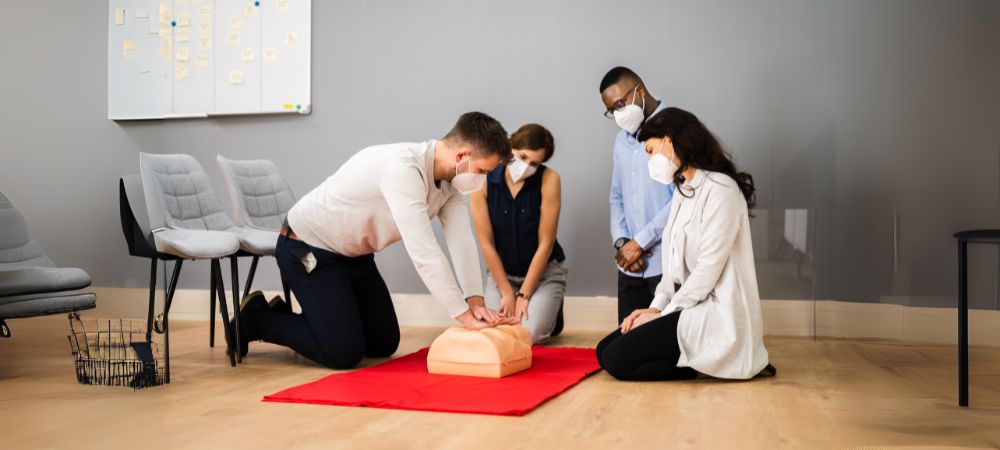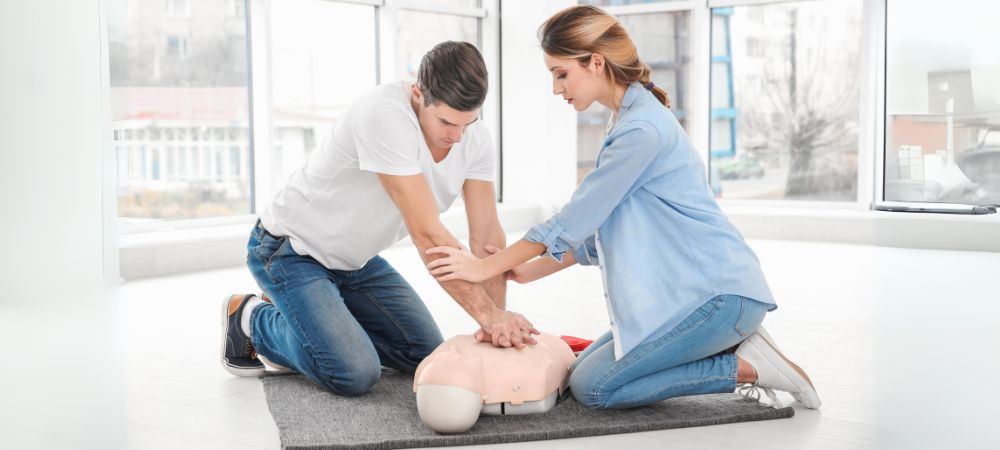Did you know that studies by the American Heart Association (AHA) and the European Resuscitation Council (ERC) reveal that bystander CPR doubles or triples the chances of survival in a person who is in cardiac arrest? Moreover, AHA research findings show that approximately 200,000 lives can be saved every year because of effective CPR.
Cardiopulmonary resuscitation (CPR) is an essential skill that saves lives, buys time, and fills the gap until professional help arrives.
If you are wondering how to get CPR certified, this step-by-step guide will help. In this CPR certification study guide, we’ll thoroughly go through the certification process and look into its importance and benefits.
What is CPR Certification?
What is CPR? CPR is basically a technique that is used in emergency situations to maintain blood circulation and oxygenation when a person’s heart has stopped working.
And what is CPR certification? It is a formal recognition that an individual has undergone training and has the ability to perform CPR effectively. This certification may be a requirement for different professions, including caregivers or lifeguards.
Being CPR certified means that you have the knowledge and the skills required to provide emergency assistance, especially in a life-threatening condition. This training basically covers basic techniques such as chest compressions, rescue breathing, and the use of an Automated External Defibrillator (AED).
Benefits of Becoming CPR Certified
Why should you become CPR-certified? Everyone should know CPR because most cardiac arrest incidents occur outside of a hospital. If that individual does not receive the necessary help, he can suffer brain damage or even die.
Here are a few other benefits of becoming CPR-certified:
- You’ll be ready to act in emergencies, whether at home, work, or in public.
- With a CPR training certification, you can perform CPR with confidence and correctly.
- Many professions require CPR certification, especially jobs in the field of healthcare and education.
- As a CPR-certified person, you can contribute to the safety and well-being of your community.
- A CPR-certified person can recognize cardiac arrest cases at an early stage.
- Any knowledge of first-aid is valuable, and having CPR certification can increase a person’s value and self-worth.
- A CPR-certified person is a source of hope for the victim and their family before professional care arrives.
The 7 Steps of Getting CPR Certified
If you are wondering how to become CPR certified, here are 7 steps that will help:
Step # 1: Research CPR Training Programs
The first step to being CPR-certified is research. Research accredited CPR training programs. Look for programs recognized by reputable organizations such as the American Red Cross and the American Heart Association. Programs recognized by such reputable organizations guarantee the quality and validity of your certification.
- When researching for accredited CPR training programs:
- Pay attention to the content of the course, its duration, and the instructor’s credibility.
- Check if the programs cover both adult and pediatric CPR, AED training, and first aid.
- Ensure that the program is recognized and accepted by regulatory bodies, especially if you need certification for professional reasons.
Step # 2: Choose the Right Course
Once you have chosen an accredited CPR training program, you need to choose the right course for yourself. There are various types of CPR courses available, including:
-
Standard CPR Training
This training is for the general public and workplace employees. This covers basic CPR skills, such as chest compressions, rescue breaths, and the use of an Automated External Defibrillator (AED), so you have the skills you need to respond quickly during an emergency situation.
-
CPR Training for Healthcare Providers
This type of CPR is designed specifically for healthcare providers, such as doctors, nurses, caregivers, and EMTs. It uses advanced techniques such as two-rescuer CPR, bag-mask ventilation, and airway maintenance, equipping healthcare providers with the essential skills they need to handle complex emergency scenarios.
-
CPR and First-Aid Training
This training combines both CPR instructions and first-aid skills, so other than CPR and AED, you can also handle common situations such as bleeding, choking, and fractures.
-
Basic Life Support (BLS) Training
BLS training is specifically designed for healthcare professionals, covers advanced CPR techniques, and is more intensive.
You can even decide between in-person, online, or blended courses based on your schedule and learning preference. Each of these courses comes with its own advantages:
-
In-person programs
In-person trainings offer hands-on experience and immediate feedback from the instructor.
-
Online Programs
Online courses are flexible, so you can learn at your own pace.
-
Blended Programs
Blended programs offer the benefits of both in-person and online programs, combining online learning with hands-on practice.
Step # 3: Enroll in a CPR Class
 Now that you have selected the course that fits your needs and schedule, it is time to sign up. Most training organizations offer an easy online registration process.
Now that you have selected the course that fits your needs and schedule, it is time to sign up. Most training organizations offer an easy online registration process.
Step # 4: Complete the Coursework
How do you get CPR certified? You need to complete the coursework, and during the course, you must participate actively in all hands-on training to master the techniques.
Step # 5: Pass the Written Exam
After completing the coursework, you’ll need to pass a written exam. This test assesses your understanding of CPR principles and procedures.
Step # 6: Perform the Skills Test
 Other than the written exam, you’ll need to show your practical skills. This skills test requires you to perform CPR techniques under the supervision of an instructor.
Other than the written exam, you’ll need to show your practical skills. This skills test requires you to perform CPR techniques under the supervision of an instructor.
Step # 7: Receive Your Certification
Upon passing both the written and skills tests, you’ll receive your certification. This certification is proof that you are now CPR-certified and can perform CPR in case of emergencies.
CPR Certification Renewal
Now that you know how to be CPR certified, it is important to note that CPR certification is not a one-time process. You have to renew your certification regularly so you can stay updated with the latest trends and techniques.
Most certifications are valid for two years, and to renew, you need to take a refresher course and pass the required exams again.
Summing Up
Becoming a CPR certified is a valuable skill that can make a significant difference in the lives of people around you. Whether you are a healthcare provider or a concerned parent, a CPR certification offers you the knowledge and confidence you need to act in emergency situations. Take the first step to becoming CPR-certified by enrolling in reputable courses recognized by the American Red Cross or the American Heart Association.
Enroll in a caregiving program by Loving Homecare and make a difference in someone’s life. Sign up now and take the first step toward a fulfilling career.
FAQs
1. Research CPR Training Programs
2. Choose the Right Course
3. Enroll in a CPR Class
4. Complete the Coursework
5. Pass the Written Exam
6. Perform the Skills Test
7. Receive Your Certification

